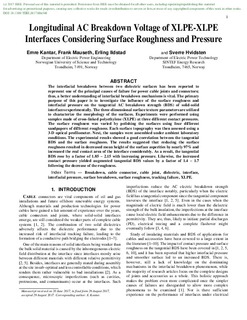| dc.contributor.author | Kantar, Emre | |
| dc.contributor.author | Hvidsten, Sverre | |
| dc.contributor.author | Mauseth, Frank | |
| dc.contributor.author | Ildstad, Erling | |
| dc.date.accessioned | 2017-11-30T09:38:59Z | |
| dc.date.available | 2017-11-30T09:38:59Z | |
| dc.date.created | 2017-10-30T14:53:31Z | |
| dc.date.issued | 2017 | |
| dc.identifier.citation | IEEE transactions on dielectrics and electrical insulation. 2017, 24 (5), 3047-3054. | nb_NO |
| dc.identifier.issn | 1070-9878 | |
| dc.identifier.uri | http://hdl.handle.net/11250/2468602 | |
| dc.description.abstract | The interfacial breakdown between two dielectric surfaces has been reported to represent one of the principal causes of failure for power cable joints and connectors; thus, a better understanding of interfacial breakdown mechanisms is vital. The primary purpose of this paper is to investigate the influence of the surface roughness and interfacial pressure on the tangential AC breakdown strength (BDS) of solid-solid interfaces experimentally. The three-dimensional surface texture parameters are utilized to characterize the morphology of the surfaces. Experiments were performed using samples made of cross-linked polyethylene (XLPE) at three different contact pressures. The surface roughness was varied by polishing the surfaces using four different sandpapers of different roughness. Each surface topography was then assessed using a 3-D optical profilometer. Next, the samples were assembled under ambient laboratory conditions. The experimental results showed a good correlation between the tangential BDS and the surface roughness. The results suggested that reducing the surface roughness resulted in decreased mean height of the surface asperities by nearly 97% and increased the real contact area of the interface considerably. As a result, the tangential BDS rose by a factor of 1.85 – 2.15 with increasing pressure. Likewise, the increased contact pressure yielded augmented tangential BDS values by a factor of 1.4 – 1.7 following the decrease of the roughness. | nb_NO |
| dc.language.iso | eng | nb_NO |
| dc.publisher | Institute of Electrical and Electronics Engineers (IEEE) | nb_NO |
| dc.relation.uri | http://ieeexplore.ieee.org/document/8120363/ | |
| dc.title | Longitudinal AC Breakdown Voltage of XLPE-XLPE Interfaces Considering Surface Roughness and Pressure | nb_NO |
| dc.type | Journal article | nb_NO |
| dc.type | Peer reviewed | nb_NO |
| dc.description.version | acceptedVersion | nb_NO |
| dc.source.pagenumber | 3047-3054 | nb_NO |
| dc.source.volume | 24 | nb_NO |
| dc.source.journal | IEEE transactions on dielectrics and electrical insulation | nb_NO |
| dc.source.issue | 5 | nb_NO |
| dc.identifier.doi | 10.1109/TDEI.2017.006540 | |
| dc.identifier.cristin | 1508989 | |
| dc.relation.project | Norges forskningsråd: 228344 | nb_NO |
| dc.description.localcode | © 2017 IEEE. Personal use of this material is permitted. Permission from IEEE must be obtained for all other uses, in any current or future media, including reprinting/republishing this material for advertising or promotional purposes, creating new collective works, for resale or redistribution to servers or lists, or reuse of any copyrighted component of this work in other works. | nb_NO |
| cristin.unitcode | 194,63,20,0 | |
| cristin.unitname | Institutt for elkraftteknikk | |
| cristin.ispublished | false | |
| cristin.fulltext | preprint | |
| cristin.qualitycode | 2 | |
